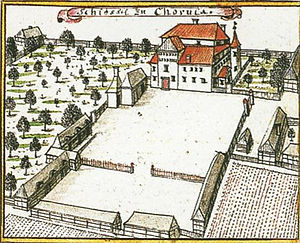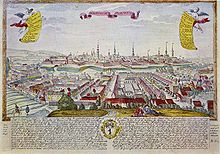Friedrich Bernhard Werner
Friedrich Bernhard Werner (born January 28, 1690 in Kamenz in Lower Silesia , other sources name Frankenstein or Reichenau (district of Kamenz) as the place of birth ; † April 20, 1776 in Breslau ) was a German draftsman and engraver.
biography
Coming from a small family, Werner first attended the Jesuit high school in Neisse, then went on a hike at a young age and led such an adventurous life as a soldier , quack , translator, writer and machine director of a theater that he called himself a "Silesian Robinson" designated. On his travels he was “informed about the art of engineering” in order to improve his drawing skills “by noting my natural instinct for drawing”.
On October 18, 1718 he married Maria Eleonora Frantz from Frankenstein.
When the Augsburg art publishers ( Jeremias Wolff's heirs) offered him the opportunity to make preliminary drawings for cityscapes in 1720 , he hiked and traveled to large parts of Europe and made the templates of numerous larger cities with great success for their copperplate engraving production as a "complete Scenographus". For a time he was also a fortress conductor in Stade and in 1729 recruiting workers for a Dutch porcelain factory , which he had collected in Bremen . Here he made a copper engraving in 1729 as a bird 's eye view of the Bremen cityscape . He then continued to travel Europe and worked as a geometer and engineer at various royal houses from 1739 . In 1744 Frederick the Great awarded him the title of Royal Prussian Scenographicus .
Werner then moved to Breslau in 1746 as a court geometer and royal scenographer and lived here until his death.
Works
His drawings of the Silesian Peace Churches , Gnadenkirchen and Prayer Houses ( 1748 - 1752 , reprinted 1989 ) and his five-volume topography of the Duchy of Silesia with around 3,000 manuscript pages and more than 1,400 colored ink drawings are important for historical house research, monument preservation, art and history , which he often made “in locu tenens”, of the greatest interest.
Hundreds of cityscapes are known from Werner, which were drawn by him and transferred to copper plates by several engravers, such as Johann Christian Leopold . The views were also templates for other artists.
- Perspective presentation of those of Sr. Königl. Majest. in Prussia, as Supreme Duke in Silesia, most graciously conceded Beth-houses AC
- Part I to V (1748–1752)
- Silesia in Compendio seu Topographia that is the presentation and description of the Duchy of Silesia […]
- Pars I ( digitized version )
- Pars II ( digitized version )
- Pars III ( digitized version )
- Pars IV ( digitized version )
- Pars V ( digitized version )
- Topographia seu prodromus principatus Silesiae […] (so-called "Neustädter Exemplar")
Vol. 1: Upper Silesia (Teschen, Ratibor, Oppeln, Troppau, Jägerndorf, Neisse, Pless, Oberbeuthen, Loslau, Friedeck, Oderberg, Bielitz) ( digitized )
Vol. 3: Münsterberg-Frankenstein, Schweidnitz, free class lords ( digitized )
Vol. 4: Liegnitz, Brieg, Wohlau ( digitized version )
Vol. 5: Glogau, Beuthen, Sagan, Schwiebus, Hirschberg ( digitized version )
- Scenographia Urbium Silesiae. Homann Erben, Nuremberg 1738 ( digitized version )
Probably between 1758 and 1765 Werner wrote an autobiography that remained unprinted and was not printed until 1921. The original was lost in 1945.
literature
- Max Hippe: Werner, Friedrich Bernhard . In: Allgemeine Deutsche Biographie (ADB). Volume 42, Duncker & Humblot, Leipzig 1897, p. 48 f.
- Paul Bretschneider: The draftsman, engraver and chronicler Friedrich Bernhard Werner and his work . Self-published, Neustadt Schlesien 1921.
- Angelika Marsch : Friedrich Bernhard Werner (1690–1776). A European draftsman from Silesia. Stiftung Kulturwerk Schlesien, Würzburg 1995, ISBN 3-929817-02-0 .
- Franz Rudolf Zankl : View of Hanover from the west. Engraving after FB Werner. Around 1785 , in the reverse. (Ed.): Hannover Archive , sheet S 15
- Angelika Marsch: Friedrich Bernhard Werner 1690–1776. Corpus of his European cityscapes, illustrated travel manuscripts and the topographies of Silesia and Bohemia-Moravia. Anton H. Konrad Verlag , Weißenhorn 2010, ISBN 978-3-87437-534-4
Individual evidence
- ^ A b c Herbert Black Forest : The Great Bremen Lexicon . 2nd, updated, revised and expanded edition. Edition Temmen, Bremen 2003, ISBN 3-86108-693-X , p.?.
- ^ Friedrich Bernhard Werner: Schlesische Bethäuser, Part I to V, 1748–1752 Reprint, Hildesheim, 1989, 469 p., ISBN 3-7848-8922-0
- ↑ Berolinum / Berlin , around 1730
Web links
- Literature by and about Friedrich Bernhard Werner in the catalog of the German National Library
- Entry on Friedrich Bernhard Werner in the database of the state's memory for the history of Lower Austria ( Museum Niederösterreich )
- Friedrich Bernhard Werner exhibition in Lower Austria (online catalog) (PDF file; 4.27 MB)
| personal data | |
|---|---|
| SURNAME | Werner, Friedrich Bernhard |
| ALTERNATIVE NAMES | Werner, BB; Werner, Bedrich Bernard; Werner, Bedrich B .; Wernher, Friedrich Bernhard; Werner, Frederick B .; Werner, FB; Werner, Ms. Bernhard |
| BRIEF DESCRIPTION | German draftsman and engraver |
| DATE OF BIRTH | January 28, 1690 |
| PLACE OF BIRTH | Frankenstein , Silesia |
| DATE OF DEATH | April 20, 1776 |
| Place of death | Wroclaw |


